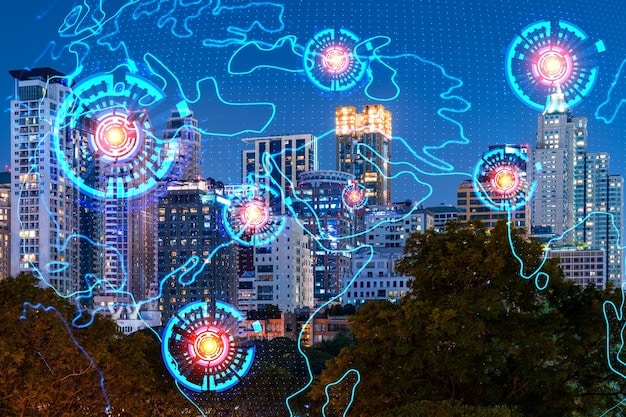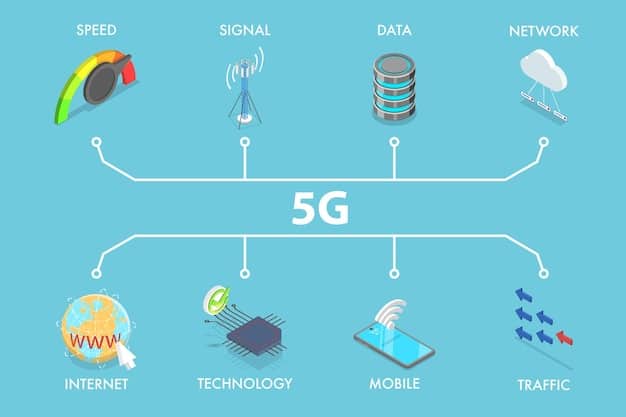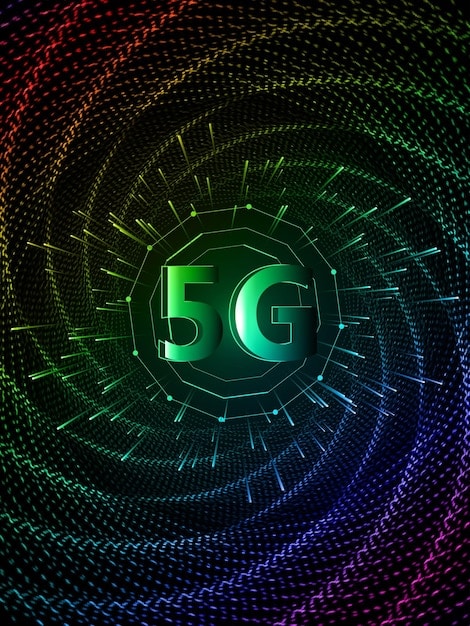5G Security: Addressing US Concerns About Vulnerabilities and Data Privacy

The Truth About 5G Security: Addressing US Concerns About Vulnerabilities and Data Privacy lies in understanding its architecture, potential vulnerabilities, and the measures being taken to safeguard data and infrastructure, especially in the face of increasing reliance on wireless technology.
As 5G technology continues to roll out across the United States, concerns about its security are growing. Understanding the truth about 5G security: Addressing US concerns about vulnerabilities and data privacy is crucial for everyone from everyday users to policymakers, ensuring that this powerful technology is both innovative and secure.
Understanding 5G Technology and Its Security Implications
5G technology promises faster speeds and lower latency, transforming how we connect and interact with devices. However, these advancements also introduce new security challenges and vulnerabilities that need careful consideration.
What is 5G and How Does it Differ From 4G?
5G, or fifth-generation wireless technology, is designed to provide significantly faster data transfer speeds, lower latency, and greater network capacity than its predecessor, 4G. This technology enables a wide range of applications, from enhanced mobile broadband to massive machine-type communications and ultra-reliable low-latency communications.
Key Architectural Differences Impacting Security
One of the significant architectural differences between 5G and 4G is the introduction of software-defined networking (SDN) and network function virtualization (NFV). These technologies provide greater flexibility and scalability but also increase the attack surface by virtualizing network functions and distributing them across multiple locations.
- 5G networks use millimeter waves, which require denser infrastructure and more cell towers, potentially increasing physical security risks.
- The increased reliance on software and virtualization in 5G networks makes them more susceptible to cyberattacks that target software vulnerabilities.
- 5G leverages network slicing, allowing multiple virtual networks to be created on the same physical infrastructure, which can introduce isolation and security configuration challenges.

The complexity of 5G architecture, combined with the increasing number of connected devices, presents unique security challenges. Addressing these concerns requires a comprehensive approach that encompasses both technical and policy measures.
Identifying the Major 5G Security Vulnerabilities
5G security vulnerabilities stem from various aspects of the technology, including hardware components, software platforms, and network protocols. Understanding these vulnerabilities is essential for developing effective security strategies.
Supply Chain Risks and Hardware Vulnerabilities
One of the primary concerns is the risk associated with the supply chain of 5G equipment. If vendors are compromised or have malicious intent, they could introduce vulnerabilities into the hardware, leading to potential backdoors or surveillance capabilities.
Software and Protocol Weaknesses
5G networks rely heavily on software and open standards, which, while beneficial for innovation, can also introduce security vulnerabilities. Flaws in network protocols, such as authentication and encryption, can be exploited by attackers to gain unauthorized access to the network or intercept sensitive data.
- Vulnerabilities in the signaling protocols used for communication between network elements can lead to denial-of-service attacks or unauthorized access.
- Weaknesses in the encryption algorithms or key management practices can compromise the confidentiality of user data transmitted over the 5G network.
- The virtualization of network functions introduces new attack vectors, as attackers can target the virtualized components and hypervisors to gain control over the network.
Addressing these vulnerabilities requires rigorous testing, secure coding practices, and continuous monitoring of 5G networks to detect and mitigate potential threats.
US Concerns About Data Privacy in 5G Networks
Data privacy is a significant concern in the context of 5G networks, as the increased data collection and analysis capabilities can potentially infringe on individual privacy rights. The US has raised several concerns regarding the handling and protection of personal data in 5G environments.
Increased Data Collection and Processing
5G networks enable a wide range of data-intensive applications, such as IoT devices, autonomous vehicles, and smart cities, which generate vast amounts of data. This data can include personal information, location data, and usage patterns, raising concerns about how it is collected, stored, and used.
Data Localization and Sovereignty Issues
The US has expressed concerns about the localization of data within certain countries, particularly those with authoritarian regimes. If data is stored and processed in countries with weak data protection laws or government surveillance practices, it could be at risk of unauthorized access or misuse.

To address these data privacy concerns, the US has advocated for strong data protection standards, including data minimization, purpose limitation, and transparency. Additionally, efforts are being made to promote trusted data flows and cross-border data transfer mechanisms that ensure adequate protection of personal data.
Mitigation Strategies for 5G Security Risks
To address the security risks associated with 5G networks, a range of mitigation strategies are being implemented by network operators, equipment vendors, and government agencies. These strategies aim to enhance the security posture of 5G infrastructure and protect against potential threats.
Enhanced Encryption and Authentication Protocols
One of the key mitigation strategies is the implementation of stronger encryption algorithms and authentication protocols. This ensures that data transmitted over the 5G network is protected from unauthorized access and that users are properly authenticated before being granted access to network resources.
Network Segmentation and Access Controls
Network segmentation involves dividing the 5G network into multiple isolated segments, each with its own security policies and access controls. This limits the impact of a potential security breach by preventing attackers from gaining access to the entire network.
- Implementing strict access controls and authorization mechanisms can limit the ability of unauthorized users or devices to access sensitive network resources.
- Regular security audits and penetration testing can help identify and address vulnerabilities in the 5G network before they can be exploited by attackers.
- Monitoring network traffic for anomalous behavior can provide early warning signs of potential security incidents, allowing for timely response and mitigation.
By implementing these mitigation strategies, network operators can significantly reduce the risk of security breaches and protect the integrity and confidentiality of 5G network services.
The Role of Government Regulations and Standards in 5G Security
Government regulations and industry standards play a crucial role in shaping the security landscape of 5G networks. These regulations and standards provide a framework for ensuring that 5G infrastructure is designed, deployed, and operated in a secure manner.
In the United States, agencies like the National Institute of Standards and Technology (NIST) are developing security frameworks and guidelines for 5G technologies.
International Collaboration and Standardization
5G security is also being addressed through international collaboration and standardization efforts. Organizations like the 3rd Generation Partnership Project (3GPP) are developing security standards for 5G networks that are adopted globally.
- Regularly updating and patching software and firmware on 5G network equipment is essential for addressing newly discovered vulnerabilities.
- Promoting cybersecurity awareness among network operators and users can help reduce the risk of social engineering attacks and other security breaches.
- Requiring vendors to adhere to minimum security standards as a condition of participating in the 5G market can help ensure a baseline level of security across the ecosystem.
Government regulations and industry standards are essential for fostering a secure and resilient 5G ecosystem that can support the diverse needs of businesses and consumers.
Future Trends in 5G Security and Data Privacy
As 5G technology continues to evolve, new security challenges and opportunities will emerge. Staying ahead of these trends is crucial for maintaining a secure and privacy-respecting 5G ecosystem.
Emerging Technologies and Security Innovations
Emerging technologies like artificial intelligence (AI) and machine learning (ML) are being used to enhance 5G security. AI-powered threat detection systems can identify and respond to security incidents in real-time, while ML algorithms can be used to predict and prevent future attacks.
Privacy-Enhancing Technologies
Privacy-enhancing technologies (PETs), such as differential privacy and homomorphic encryption, are being developed to protect user data in 5G networks. These technologies allow data to be analyzed and processed without revealing sensitive information, ensuring that user privacy is preserved.
The future of 5G security relies on ongoing collaboration between researchers, industry stakeholders, and government agencies to develop and implement innovative security solutions that can address the evolving threat landscape and protect user privacy.
| Key Aspect | Brief Description |
|---|---|
| 🛡️ Vulnerabilities | Identifies hardware, software, and protocol-based security flaws. |
| 🔒 Data Privacy | Addresses US concerns about increased data collection and sovereignty issues. |
| 🛡️ Mitigation | Employs encryption, segmentation, and stringent access controls. |
| 🌐 Regulations | Outlines government and international standards for security. |
FAQ Section
▼
Key concerns include supply chain vulnerabilities, software flaws, and potential for increased data collection and privacy infringements. These are exacerbated by network virtualization.
▼
The US promotes strong data protection standards, including data minimization and transparency, and advocates for trusted cross-border data transfer mechanisms to safeguard personal data.
▼
Mitigation strategies include enhanced encryption, network segmentation, strict access controls, regular security audits, and AI-powered threat detection systems to protect against potential breaches.
▼
Government regulations and industry standards define security frameworks, ensure secure design and deployment, and promote cybersecurity awareness, establishing a baseline for the 5G ecosystem.
▼
Future trends involve employing AI and machine learning for advanced threat detection and using privacy-enhancing technologies like differential privacy to protect user data in 5G networks.
Conclusion
In conclusion, while 5G technology offers immense potential, addressing its security vulnerabilities and data privacy concerns is paramount. Through robust mitigation strategies, stringent regulations, and continuous innovation, we can harness the power of 5G while safeguarding our data and infrastructure.





